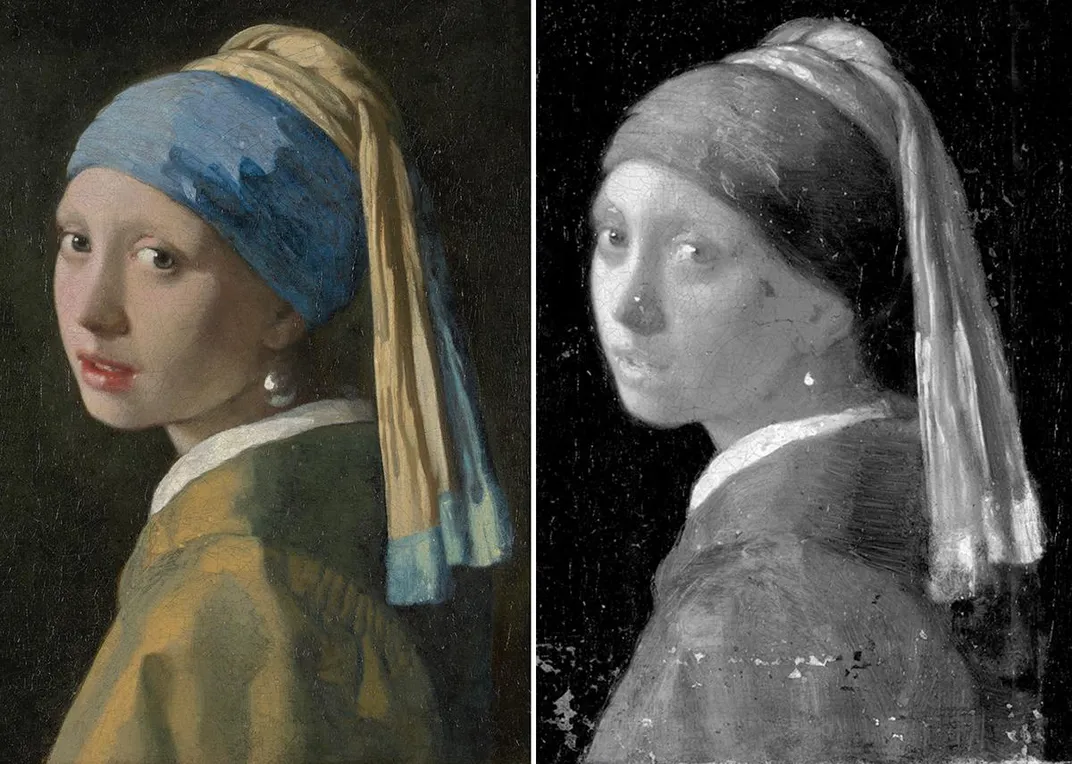Researchers Reveal Hidden Details in Vermeer’s ‘Girl With a Pearl Earring’
New scans revealed the figure’s now-faded eyelashes and green backdrop, but her identity remains a mystery
:focal(975x601:976x602)/https://tf-cmsv2-smithsonianmag-media.s3.amazonaws.com/filer/0b/01/0b010793-cf40-42fa-8390-f228102326fd/2020_apr29_pearlearring.jpg)
On Tuesday, a team of researchers working with the Mauritshuis Museum in the Hague unveiled the results of its two-year examination of Johannes Vermeer’s Girl With a Pearl Earring.
Though the experts didn’t come any closer to discovering the figure’s much-debated identity, they were able to use modern imaging techniques to peer beneath the top layers of the finished painting in more detail than ever before.
The analysis revealed an array of previously unseen features: Per a press release, the mysterious sitter originally appeared not in a gray void, but in front of a dark green curtain. Vermeer also revised several elements of the work’s composition, including the position of the girl’s ear, the top of her headscarf and the back of her neck. Though invisible to the naked eye, the figure does, in fact, have eyelashes.
“We were able to find out so much about Vermeer’s materials and techniques, but we still don’t know exactly who the girl is,” project head and conservator Abbie Vandivere tells the Guardian’s Mark Brown. “It is good that some mysteries remain and everyone can speculate about her. It allows people their own personal interpretation of the girl; everyone feels their own connection with the way she meets your eyes.”
The artwork, completed around 1665, is one of Vermeer’s best-known works. Many of the 17th-century artist’s paintings center on women engaging in quotidian tasks such as reading, writing and playing musical instruments. In contrast, Girl With a Pearl Earring features an unnamed young woman looking over her shoulder to gaze directly at the viewer.
While it may seem like a conventional portrait, the 1665 work is actually a tronie, or painting that emphasizes character and costume over the depiction of a specific subject. According to the Essential Vermeer database, “The tronie furnished the artist [with] an opportunity to demonstrate his ability in rendering fine stuffs, an exotic garment or characteristic facial type.”
Vermeer’s eponymous girl wears a fashionable gold jacket, a blue-and-gold head scarf, and a large pearl earring. The scarf stood out to researchers analyzing the pigments used by the Dutch Golden Age giant, explains Vandivere in a video published by the Mauritshuis. The vibrant blue was derived from the semiprecious stone lapis lazuli, which was heated and ground up to produce a pigment.
“It’s surprising how much high quality ultramarine Vermeer used in the girl’s headscarf,” Vandivere tells the Associated Press’ Mike Corder. “This blue pigment was more valuable than gold in the 17th century.”
Blue wasn’t the only Girl With a Pearl Earring hue used that originated further afield, according to the Guardian. While the painting’s yellow and brown pigments could have been mined in Europe, the red used in the figure’s lips came from insects that lived on cacti in Mexico and South America. The white that highlights her eyes and earring was made from lead mined in England, and the dark blue in the background came from either Asian or North American indigo. Thanks to global trade, the pigments were likely all available for purchase in Vermeer’s hometown of Delft.

“So our question ‘Which materials did Vermeer use and where did they come from?’ not only tells us about where the pigments in Girl With a Pearl Earring come from, but also … about Dutch and world trade in the 17th century,” says Vandivere in the museum’s video.
The researchers mapped the painting’s pigments using modern imaging techniques. Additionally, they tested tiny fragments of paint removed from the artwork’s background in the 1990s, when it was last restored. The samples were embedded in resin and sliced in half to reveal the layers inside, yielding a mix of yellow and indigo pigments that had degraded in the light over time. Modern imaging also revealed the presence of faint, diagonal lines of lead white in the painting’s upper right corner. Together, the results show that when Vermeer first painted the Girl With a Pearl Earring, a dark green curtain was draped in its background.
Vermeer is famed for his use of light. In the painting, light reflects differently on the girl’s skin, lips, clothes and earring. The museum took a close look at the techniques the artist used to achieve the different effects: A thin brushstroke of white paint on the lower highlight of the earring reflects the collar, for instance, while a thicker daub of paint on the accessory’s top depicts the reflection of the light source.
Still, a lasting question remains: Who was the girl?
Speaking in an online presentation quoted by the Associated Press, Martine Gosselink, the Mauritshuis’ director, said, “No, sadly we didn’t find out who this young lady was and if she ever really existed. But we did get a little closer to her.”

